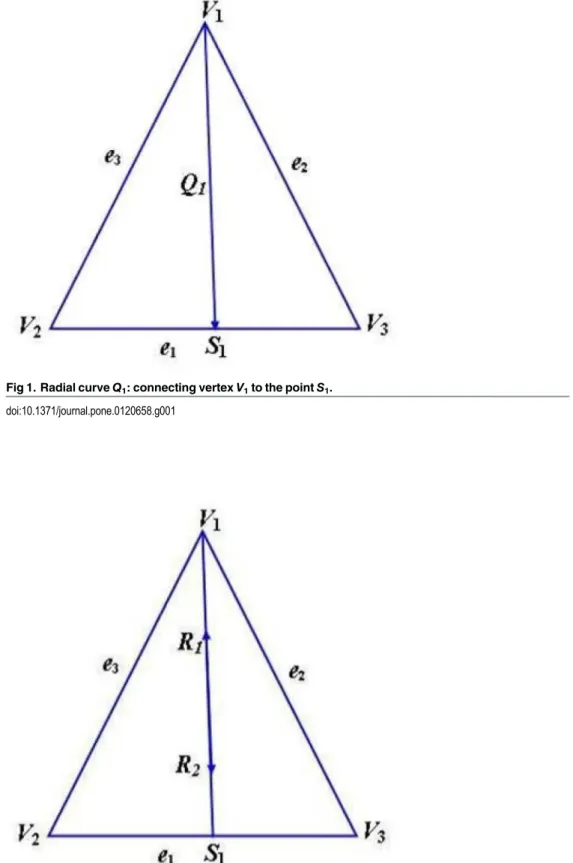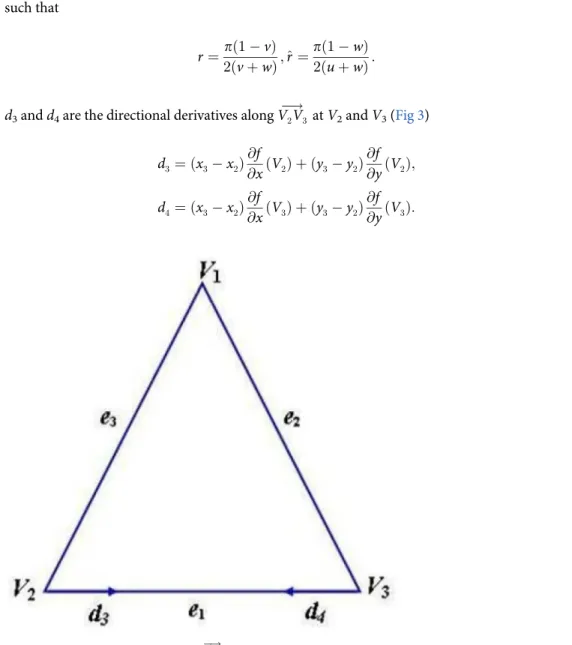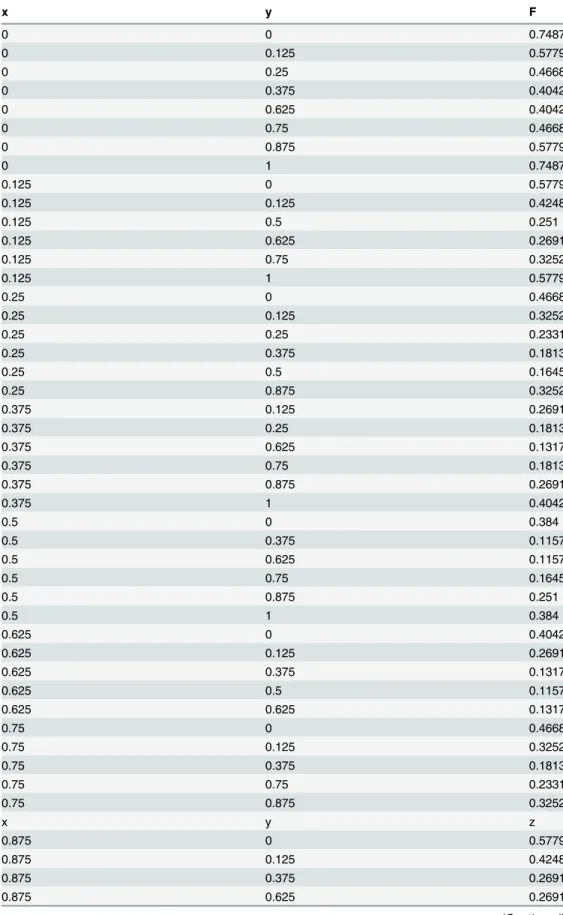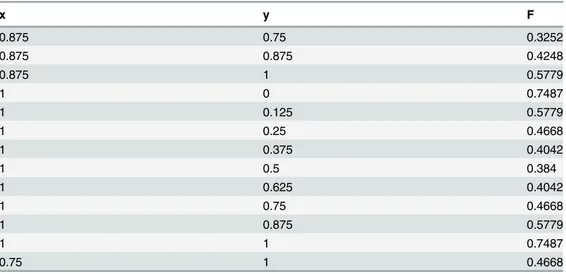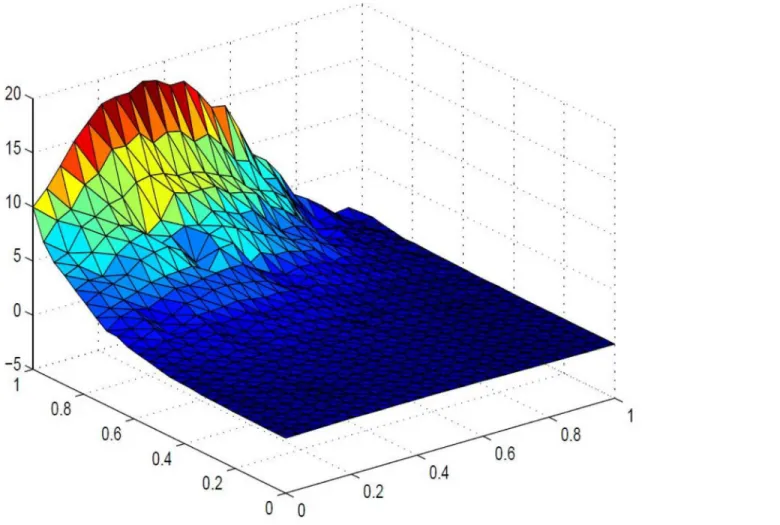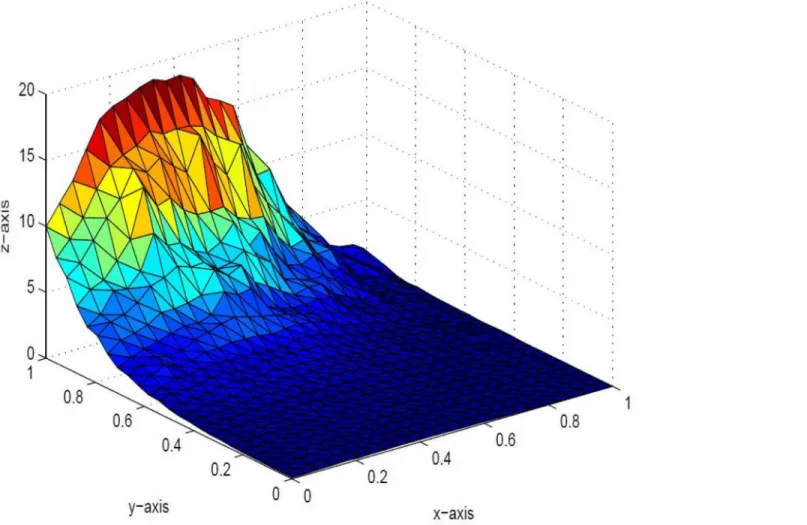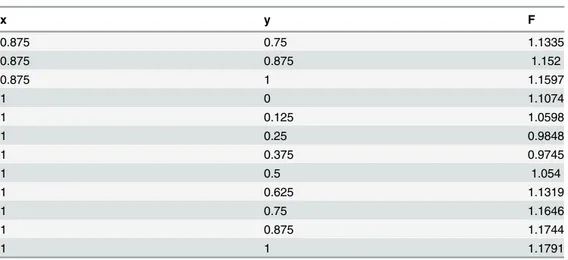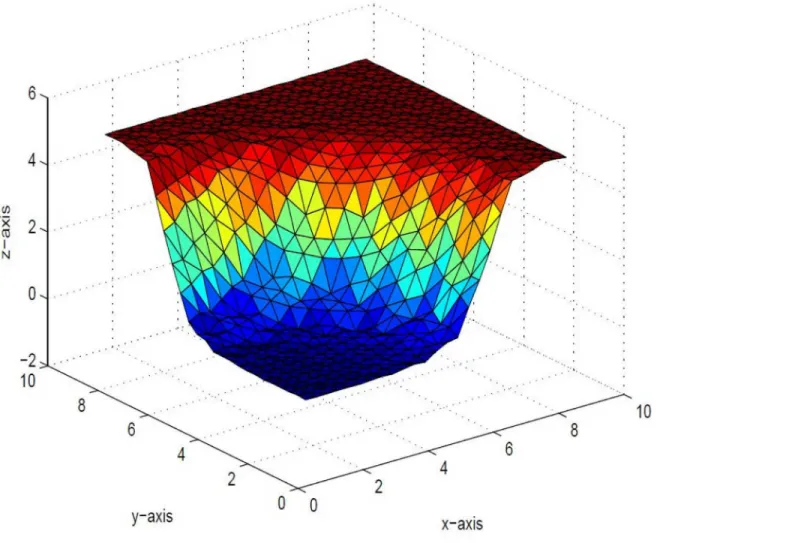Data Sites
Farheen Ibraheem1*, Malik Zawwar Hussain2, Akhlaq Ahmad Bhatti1
1National University of Computer and Emerging Science, Lahore, Pakistan,2Department of Mathematics, University of the Punjab, Lahore, Pakistan
*farheen.butt@gmail.com
Abstract
The aim of this paper is to develop a local positivity preserving scheme when the data amassed from different sources is positioned at sparse points. The proposed algorithm first triangulates the irregular data using Delauny triangulation method, therewith interpolates each boundary and radial curve of the triangle byC¹ rational trigonometric cubic function. Half of the parameters in the description of the interpolant are constrained to keep up the positive shape of data while the remaining half are set free for users’requirement. Orthogo-nality of trigonometric function assures much smoother surface as compared to polynomial functions. The proposed scheme can be of great use in areas of surface reconstruction and deformation, signal processing, CAD/CAM design, solving differential equations, and image restoration.
1. Introduction
Data measured or amassed from many engineering and scientific fields, is often positioned at sparse points. For example, meteorological measurements at different weather stations [1], density measurements on different positions within the human body, heart potential measure-ments at random points in the diagnosis of various ailmeasure-ments of heart [2], 3D photography, aeronautical engineering and industrial design, structural graph networks [3], graph entropy [4], [5], [6]. A visual model is often required to get a clear understanding of underlying phe-nomena as colossal amount of data is difficult to analyse or communicate a message in raw form. Further, a meticulous visual representation obligates the interpolating function to affirm intrinsic attributes of data like positivity, monotonicity and convexity. Although, tensor prod-uct provides a robust medium for fitting surface to rectilinear data sites, it can not be used to fit a surface over sparse data points. This paper addresses the problem of retaining positivity over scattered data points.
Several approaches have been proposed in literature to address the problem of positivity preserving interpolating surfaces. Amidor [7] surveyed method to interpolate scattered data necessitating from electronic imaging system. The author mainly examined radial basis func-tion method, tetrahedral interpolafunc-tion, cubic triangular interpolafunc-tion, triangle based blending interpolation, inverse distance method and neutral neighbourhood. The difference between
a11111
OPEN ACCESS
Citation:Ibraheem F, Hussain MZ, Bhatti AA (2015) C¹ Positive Surface over Positive Scattered Data
Sites. PLoS ONE 10(6): e0120658. doi:10.1371/ journal.pone.0120658
Academic Editor:Cheng-Yi Xia, Tianjin University of Technology, CHINA
Received:July 12, 2014
Accepted:February 5, 2015
Published:June 9, 2015
Copyright:© 2015 Ibraheem et al. This is an open access article distributed under the terms of the
Creative Commons Attribution License, which permits unrestricted use, distribution, and reproduction in any medium, provided the original author and source are credited.
Data Availability Statement:All relevant data are within the paper.
Funding:The authors have no support or funding to report.
scattered data interpolation and scattered data fitting was also demonstrated in the survey. Cubic and quintic Hermite interpolants were used for preserving monotonicity, positivity and convexity of discrete data by [8]. Piah, Goodman, Unsworth [9] first triangulated the data points by Delaunay triangulation and constructed the interpolating surface consisting of“cubic Bezier triangular patches”. Positivity of data was achieved by imposing sufficient conditions on Bezier ordinates in each triangular patch. The proposed scheme was local andC1continous. Hussain and Hussain [10] arranged the scattered data over a triangular grid to preserve the positivity and monotonicity. The authors used a cubic interpolant with one parameter to inter-polate the boundary of each triangular patch while linear interpolant was used in Nielson side vertex method to obtain radial curves. Final surface patch was obtained by convex combination of interpolants. Positivity and monotonicity was retained by deriving data dependent con-straints on free parameters.C1Quadratic splines and Powell-Sabin splines were used as inter-polating function to tackle the problem of range restricted univariate and bivariate scattered data by Hermann et. al. [11]. The authors obtained a system of inequalities for the gradients and positivity was accomplished by deriving sufficient conditions on this system. AC1local ra-tional cubic Bernstein Bezier interpolatory scheme was proposed by Hussain and Hussain [12] to retain positivity of scattered data. In each triangular patch, inner and boundary Bezier ordi-nates were confined for positivity. If in any triangular grid, Bezier ordiordi-nates failed to attain pos-itive shape of data, then these were varied by the weights described in formation of rational cubic Bernstein Bezier interpolant. Sarfraz et. al. [1] established a localC1approach to keep up the positivity of scattered data positioned over a triangular domain. They employedC1rational cubic function with four parameters in Nielson side vertex technique to formulate the interpo-lating surface. Two of the four parameters were constrained for positivity.
Although several approaches have been proposed to retain the positivity of data, little atten-tion has been paid towards the use of trigonometric basis funcatten-tion. This paper develops a posi-tivity preserving scheme for scatter data by takingC1rational trigonometric function [13] into account. Delaunay triangulation method has been used to place scatter data as vertices of trian-gle. Nielson side vertex method [14] has been employed in each triangle to construct triangular patches. TheC1rational trigonometric cubic function [13] with four parameter has been used for the interpolation along boundary and radial curve of the triangle. Positivity is attained by deriving data dependent condition on half of the parameters in the description ofC1rational trigonometric cubic function [13].
The remainder of the paper is formulated as: Section 2 reviews the ratonal trigonometric cubic function [13]. Nielson side vertex method [14] to formulate triangular patches is detailed in Section 3. Positivity preserving algorithm is developed and explained in Section 4. Section 5 demonstrates the developed algorithm and presents graphical results. Section 5 summarizes this research and draws conclusion.
2. Rational Trigonometric Cubic Function
Let {(xi,yi),i= 0,1,2,. . .,n−1} be the given set of data points defined over the interval [a,b]
wherea=x0<x1<x2<. . .<xn=b. A piecewise rational trigonometric cubic function is
de-fined over each subintervalIi= [xi,xi+1] as
SiðxÞ ¼
piðyÞ
qiðyÞ
piðyÞ ¼ aifið1 sinyÞ
3
þ bifiþ 2hiaidi
p
sinyð1 sinyÞ2
þ gifiþ1
2hididiþ1
p
cosyð1 cosyÞ2þdifiþ1ð1 cosyÞ 3
qiðyÞ ¼ aið1 sinyÞ
3
þbisinyð1 sinyÞ2þgicosyð1 cosyÞ2þdið1 cosyÞ3
where
y¼p
2
x xi
hi
;hi ¼xiþ1 xi; i¼0;1;2; :::;n 1
The rational trigonometric cubic function (Eq 1) satisfy the following properties:
SðxiÞ ¼fi;Sðxiþ1Þ ¼fiþ1;S0ðxiÞ ¼di;S0ðxiþ1Þ ¼diþ1: ð2Þ
dianddi+1are derivative at the endpoints of the intervalIi= [xi,xi+1].αi,βi,γiandδiare the
free parameters. The following result has been proved in [13].
Theorem 2.1The C1piecewise rational trigonometric cubic function preserve the positivity of positive data if in each subinterval Ii= [xi,xi+1], the parametersβiandγisatisfy the following
suf-ficient conditions
bi¼uiþmax 0;
2hidiai
pfi
;ui>0;
gi¼viþ max 0;
2hidiþ1di
pfiþ1
;vi>0:
3. Nielson Side Vertex Method
Consider a triangle4V1V2V3with verticesV1,V2,V3having edgese1,e2,e3andu,v,wbe the
barycentric coordinates such that any pointVon the triangle can be written as:
V¼:uV1þvV2þwV3; ð3Þ
where
uþvþw¼1andu;v;w0:
The interpolant defined by Nielson [14] to generate surface over each triangular patch is de-fined as the following convex combination:
Pða;b;cÞ ¼v
2w2Q
1þu
2w2Q 2þu
2v2Q 3
v2w2þu2w2þu2v2 : ð4Þ
whereQi
0
srepresent line segments joining verticesV0
isto pointsS
0
ison the opposite boundary.
Eq (4)interpolates data at the vertices as well asfirst order derivatives at the boundary. Since the barycentric coordinates at the vertices of triangle is simultaneously zero, the interpolantEq (4)takes the following values:
Pða;b;cÞ ¼Q1whenv¼w¼0;
Pða;b;cÞ ¼Q2whenu¼w¼0;
Pða;b;cÞ ¼Q3;whenv¼u¼0;
4. Positive Scatter Data Interpolation
This section details the derivation of sufficient conditions forC1triangular patches to be posi-tive. Let the given positive scattered data set arranged over a triangular domain be {(xi,yi,Fi),
i= 1,2,. . .,n}. The resulting surfaceS(x,y) described as
Sðxi;yiÞ ¼Fi;i¼1;2; :::;n; ð5Þ
is positive if
Sðx;yÞ>0;8ðx;yÞ 2D: ð6Þ
4.1 Domain Triangulation
Triangulation of data is performed by Delaunay triangulation method such that dataFi, fall on
vertices {Vi= (xi,yi),i= 1,2,3,. . .,n} of the triangles.
4.2 Estimation of Derivatives
Partial derivatives at the verticesVi,i= 1,2,3 of each triangle are calculated by derivative
esti-mation scheme suggested by Goodman et. al. [15]
4.3
C
1Positive triangular patch
LetV1V2V3be the given triangle with edgesei,i= 1,2,3 opposite to the verticesVi,i= 1,2,3
re-spectively andSi,i= 1,2,3 be the points on the edges opposite to verticesVi,i= 1,2,3. The radial
curveQ1connecting vertexV1to the pointsS1on the opposite edgese1is defined as (Fig 1):
Q1¼
Q1n
Q1d
; ð7Þ
where
Q1n ¼ ð1 sinlÞ
3
F1a1þsinlð1 sinlÞ 2
b1F1þ
2R1a1
p
þ cosl^ð1 cos^lÞ2
g1FðS1Þ
2d1R2
p
þ ð1 cos^lÞ3
d1FðS1Þ;
Q1d ¼ a1ð1 sinlÞ 3
þb1sinlð1 sinlÞ2þg1cos^lð1 cos^lÞ2þd1ð1 cosl^Þ3:
such that
l¼p
2ð1 uÞ; ^
l¼1 l:
R1andR2are the directional derivatives atV1andS1(Fig 2) defined as
R1 ¼ ðxs1 x1Þ
@f
@xðV1Þ þ ðys1 y1Þ
@f
@yðV1Þ;
R2 ¼ ðxs1 x1Þ
@f
@xðS1Þ þ ðys1 y1Þ
@f
@yðS1Þ:
andF(S1) is the boundary curve along the edgee1evaluated from the following expression
FðS1Þ ¼
F1n
F1d
Fig 2. Directional derivatives alongS1!V1.
doi:10.1371/journal.pone.0120658.g002
Fig 1. Radial curveQ1: connecting vertexV1to the pointS1.
where
F1n ¼ ð1 sinrÞ
3
F2a4þsinrð1 sinrÞ 2
b4F2þ
2d3a4
p
þ cos^rð1 cos^rÞ2 g4F3
2d4d4
p
þ ð1 cos^rÞ3d4F3;
F1d ¼ a4ð1 sinrÞ 3
þb4sinrð1 sinrÞ 2
þg4cos^rð1 cos^rÞ 2
þd4ð1 cos^rÞ 3
:
such that
r¼pð1 vÞ
2ðvþwÞ;^r ¼
pð1 wÞ
2ðuþwÞ:
d3andd4are the directional derivatives alongV2V3
!
atV2andV3(Fig 3)
d3¼ ðx3 x2Þ @f
@xðV2Þ þ ðy3 y2Þ @f
@yðV2Þ;
d4¼ ðx3 x2Þ @f
@xðV3Þ þ ðy3 y2Þ @f
@yðV3Þ:
Fig 3. Directional derivatives alongV2!V3.
FromEq 7,Q1>0 if
Q1n>0andQ1d >0:
Now,Q1n>0 if
a1 >0;d1>0;
b1>
2R1a1
pF1 ;
g1> 2R2d1
pFðS1Þ ;
FðS1Þ>0 :
ð8Þ
From Theorem 2.1,F(S1)>0 if
b4>
2a4d3
pF2 ;g4>
2d4d4
pF3
: ð9Þ
Now,Q1d>0 if
a1 >0;b1>0;g1>0and d1 >0:
Likewise, radial curveQ2connecting vertexV2to the pointsS2on the opposite edgese2is
de-fined as
Q2 ¼
Q2n
Q2d
; ð10Þ
where
Q2n ¼ ð1 sinmÞ
3
F2a2þ sinmð1 sinmÞ 2
b2F2þ
2R3a2
p
þ cosm^ð1 cosm^Þ2 g2FðS2Þ
2d2R4
p
þ ð1 cosm^Þ3d2FðS2Þ;
Q2d ¼ a2ð1 sinmÞ 3
þb2sinmð1 sinmÞ2þg2cosm^ð1 cos^mÞ2þd2ð1 cosm^Þ3:
such that
m¼p
2ð1 vÞ;m^¼1 m: ð11Þ
R3andR4are the directional derivatives atV2andS2
R3 ¼ ðxs2 x2Þ
@f
@xðV2Þ þ ðys2 y2Þ
@f
@yðV2Þ
R4 ¼ ðxs2 x2Þ
@f
@xðS2Þ þ ðys2 y2Þ
@f
@yðS2Þ
andF(S2) is the boundary curve along the edgee2to be evaluated from the following
expres-sion
FðS2Þ ¼
F2n
F2d
where
F2n ¼ ð1 sinsÞ
3
F3a5þsinrð1 sinrÞ 2
b5F3þ
2d5a5
p
þ cosrð1 cosrÞ2 g5F1
2d5d6
p
þ ð1 cosrÞ3d5F1;
F2d ¼ a5ð1 sinrÞ 3
þb5sinrð1 sinrÞ 2
þg5cosrð1 cosrÞ 2
þd5ð1 cosrÞ 3
:
d5andd6are the directional derivatives alongV1V3
!
atV1andV3
d5 ¼ ðx1 x3Þ @f
@xðV3Þ þ ðy1 y3Þ @f
@yðV3Þ;
d6 ¼ ðx3 x2Þ @f
@xðV1Þ þ ðy3 y2Þ @f
@yðV1Þ:
FromEq 10,Q2>0 if
Q2n>0andQ2d >0:
Now,Q2n>0 if
a2>0; d2>0;
b2>
2R3a2
pF2 ;
g2 >
2R4d2
pFðS2Þ ;
FðS2Þ>0 :
ð12Þ
From Theorem 2.1,F(S2)>0 if
b5 >
2a5d5
pF3 ;g5 >
2d5d6
pF1
: ð13Þ
Now,Q2d>0 if
a2>0;b2 >0;g2 >0andd2>0:
and the radial curveQ3connecting vertexV3to the pointS3on the opposite edgee3is defined
as
Q3 ¼
Q3n
Q3d
; ð14Þ
where
Q3n ¼ ð1 sinnÞ
3
F3a3þsinnð1 sinnÞ 2
b3F3þ
2R5a3
p
þ cosnð1 cosnÞ2
g3FðS3Þ
2d3R6
p
þ ð1 cosnÞ3
d3FðS3Þ;
Q3d ¼ a3ð1 sinnÞ 3
þb3sinnð1 sinnÞ 2
þg3cosnð1 cosnÞ 2
þd3ð1 cosnÞ 3
whereR5andR6are the directional derivatives atV3andS3defined as
R5 ¼ ðxs3 x3Þ
@f
@xðV3Þ þ ðys3 y3Þ
@f
@yðV3Þ
R6 ¼ ðxs3 x3Þ
@f
@xðS3Þ þ ðys3 y3Þ
@f
@yðS3Þ
andF(S3) is the boundary curve along the edgee3to be evaluated from the following
expres-sion
FðS3Þ ¼
F3n
F3d
;
where
F3n ¼ ð1 sintÞ
3
F1a6þ sintð1 sintÞ 2
b6F1þ
2d1a6
p
þ costð1 costÞ2 g6F2
2d6d2
p
þ ð1 costÞ3d6F2;
F3d ¼ a6ð1 sintÞ 3
þb6sintð1 sintÞ2þg6costð1 costÞ2þd6ð1 costÞ3:
d1andd2are the directional derivatives alongV1V2
!
atV1andV2
d5 ¼ ðx2 x1Þ @f
@xðV1Þ þ ðy2 y1Þ @f
@yðV1Þ;
d6 ¼ ðx2 x1Þ @f
@xðV2Þ þ ðy2 y1Þ @f
@yðV2Þ:
FromEq 14,Q3>0 if
Q3n>0 and Q3d >0:
Now,Q3n>0 if
a3>0; d2>0;
b3>
2R5a3
pF3 ;
g3 >
2R6d3
pFðS3Þ ;
FðS3Þ>0 :
ð15Þ
From Theorem 2.1,F(S3)>0 if
b6 > 2a6d1
pF1
;g6 >2d6d2
pF2
: ð16Þ
Now,Q3d>0 if
a3 >0;b3>0;g3>0and d3 >0:
Theorem 4.1The C1triangular pactch P inEq (4)is positive if the following conditions are attained.
a1>0;a2>0;a3 >0;a4>0;a5>0;a6 >0;
d1>0;d2>0;d3 >0;d4>0;d5>0;d6 >0;
b1> max 0; 2R1a1
pF1
;g1 > max 0;2R2d1
pFðS1Þ
;
b2> max 0;
2R3a2
pF2
;g2 > max 0;
2R4d2
pFðS2Þ
;
b3> max 0;
2R5a3
pF3
;g3 > max 0;
2R6d3
pFðS3Þ
;
b4> max 0;
2a4d3
pF2
;g4> max 0;
2d4d4
pF3
;
b5> max 0; 2a5d5
pF3
;g5> max 0;2d5d6
pF1
;
b6> max 0; 2a6d1
pF1
;g6> max 0;2d6d2
pF2
:
The above constraints can be rearranged as
b1>l1þmax 0;
2R1a1
pF1
;g1 >m1þmax 0;
2R2d1
pFðS1Þ
;l1;m1>0;
b2>l2þmax 0;
2R3a2
pF2
;g2 >m2þmax 0;
2R4d2
pFðS2Þ
;l2;m2>0;
b3>l3þmax 0;
2R5a3
pF3
;g3 >m3þmax 0;
2R6d3
pFðS3Þ
;l3;m3>0;
b4>l4þmax 0;
2a4d3
pF2
;g4>m4þmax 0;
2d4d4
pF3
;l4;m4>0;
b5>l5þmax 0;
2a5d5
pF3
;g5>m5þmax 0;
2d5d6
pF1
;l5;m5>0;
b6>l6þmax 0;
2a6d1
pF1
;g6>m6þmax 0;
2d6d2
pF2
;l6;m6>0:
5. Numerical Examples
This section illustrates the positivity preserving scheme for scattered data devised in Section 4.3.
Example 5.1Positive scattered data is taken inTable 1.Fig 4represents corresponding delau-nay triangulations. The data is interpolated first byEq (4)for arbitrary values of free parame-ters,α1= 4.1,α2= 3;α3= 2.5,α4= 1.6,α5= 2.7,α6= 2.8,β1= 3.8,β2= 2.4,β3= 4.2,β4= 2.5,β5
Table 1. A Positive scattered data set I.
x y F
0 0 0.7487
0 0.125 0.5779
0 0.25 0.4668
0 0.375 0.4042
0 0.625 0.4042
0 0.75 0.4668
0 0.875 0.5779
0 1 0.7487
0.125 0 0.5779
0.125 0.125 0.4248
0.125 0.5 0.251
0.125 0.625 0.2691
0.125 0.75 0.3252
0.125 1 0.5779
0.25 0 0.4668
0.25 0.125 0.3252
0.25 0.25 0.2331
0.25 0.375 0.1813
0.25 0.5 0.1645
0.25 0.875 0.3252
0.375 0.125 0.2691
0.375 0.25 0.1813
0.375 0.625 0.1317
0.375 0.75 0.1813
0.375 0.875 0.2691
0.375 1 0.4042
0.5 0 0.384
0.5 0.375 0.1157
0.5 0.625 0.1157
0.5 0.75 0.1645
0.5 0.875 0.251
0.5 1 0.384
0.625 0 0.4042
0.625 0.125 0.2691
0.625 0.375 0.1317
0.625 0.5 0.1157
0.625 0.625 0.1317
0.75 0 0.4668
0.75 0.125 0.3252
0.75 0.375 0.1813
0.75 0.75 0.2331
0.75 0.875 0.3252
x y z
0.875 0 0.5779
0.875 0.125 0.4248
0.875 0.375 0.2691
0.875 0.625 0.2691
Table 1. (Continued)
x y F
0.875 0.75 0.3252
0.875 0.875 0.4248
0.875 1 0.5779
1 0 0.7487
1 0.125 0.5779
1 0.25 0.4668
1 0.375 0.4042
1 0.5 0.384
1 0.625 0.4042
1 0.75 0.4668
1 0.875 0.5779
1 1 0.7487
0.75 1 0.4668
doi:10.1371/journal.pone.0120658.t001
Fig 4. Delaunay triangulation of positive data inTable 1.
of positivity of data could no be held in visual model. This detriment is removed inFigs6,7and 8by implementing positivity preserving conditions summarized in Theorem 4.1. It is worth men-tioning here that parametersαiandδifor i= 1,2,. . .,6are left free to refine the shape according to user’s requirement. The effect of free parameters are shown inFigs6,7and8. Figs6and7are constructed against the parameter choiceα1= 12,α2= 0.4,α3= 13,α4= 0.22,α5= 12,α6= 0.33,
δ1= 13,δ2= 0.3,δ3= 14,δ4= 0.3,δ5= 15,δ6= 12 andα1= 0.1,α2= 1.0,α3= 0.5,α4= 1.6, α5= 0.7,α6= 0.8,δ1= 0.8,δ2= 0.4,δ3= 1.2,δ4= 1.5,δ5= 1.5,δ6= 1.0respectively, which lacks smoothness. A smooth visibly pleasant representation is obtained inFig 8by settingα1= 1.0, α2= 1.0,α3= 0.5,α4= 0.6,α5= 0.7,α6= 0.8,δ1= 0.8,δ2= 0.4,δ3= 1.2,δ4= 0.5,δ5= 1.0,
δ6= 1.0
Example 5.2A Positive scattered data set is displayed inTable 2.Delauny triangulation is il-lustrated inFig 9and the corresponding surface inFig 10is obtained by interpolating the data Fig 5. Rational cubic trigonometric surface of the positive data inTable 1.
for arbitrary values of free parameters,α1= 4.1,α2= 3;α3= 2.0,α4= 1.5,α5= 2.7,α6= 2.5,β1= 3.5,β2= 2.3,β3= 3.2,β4= 2.2,β5= 1.0,β6= 4.5,γ1= 1.4,γ2= 5.5,γ3= 1.5,γ4= 2.2,γ5= 1.5,γ1
= 2.5,δ1= 0.5,δ2= 3.1,δ3= 3.5,δ4= 0.4,δ5= 2,δ6= 1.2,in description ofEq (4).It is evident fromFig 10that the positivity of data could not be conserved in visual model. This impediment is removed inFigs11,12andFig 13by implementing positivity preserving constraints on parame-tersβi,γifor i= 1,2,. . .,6,summarized in Theorem 4.1. Here, it is noteworthy that parametersαi
andδifor i= 1,2,. . .,6are set free to refine the shape as required by the user. The effect of free pa-rameters are shown inFigs11,12and13. Figs11and12are constructed against the parameter choiceα1= 2.0,α2= 0.1,α3= 0.5,α4= 0.5,α5= 1.0,α6= 0.63,δ1= 1.0,δ2= 0.33,δ3= 0.5,δ4= 0.4,δ5= 1.0,δ6= 0.3andα1= 2.2,α2= 1.1,α3= 2.5,α4= 1.5,α5= 1.0,α6= 1.0,δ1= 1.0,δ2=
1.0,δ3= 1.5,δ4= 1.4,δ5= 1.0,δ6= 0.3respectively, which lacks smoothness. A smooth visibly pleasant representation is obtained inFig 13by settingα1= 2.0,α2= 0.4,α3= 0.5,α4= 0.5,α5=
1.0,α6= 0.63,δ1= 0.3,δ2= 0.33,δ3= 0.5,δ4= 0.3,δ5= 0.5,δ6= 0.2. Fig 6. Positive surface generated from Theorem 4.1 of the positive data inTable 1.
Conclusion
In this study, positivity preserving algorithm for scattered data arranged over a triangular do-main, is established. The rational trigonometric cubic function [13] with four free parameters is used for the interpolation along each boundary and radial curve. Nielson side vertex has been applied to construct the interpolating surface. Constraints on half of the parameters are obtained to guarantee the positive shape of data while half are set free for users modification. The proposed algorithm, surpasses many prevailing approaches in literature. In [10], authors Fig 7. Positive surface generated from Theorem 4.1 of the positive data inTable 1.
Fig 8. Positive surface generated from Theorem 4.1 of the positive data inTable 1.
doi:10.1371/journal.pone.0120658.g008
Table 2. A Positive scattered data set II.
x y F
0 0 0.4486
0 0.125 0.3616
0 0.25 0.4692
0 0.375 0.6827
0 0.5 0.786
0 0.625 0.836
0 0.75 0.8765
0 0.875 0.9125
0 1 0.9447
0.125 0 0.3369
0.125 0.125 0.0001
0.125 0.375 0.6256
0.125 0.625 0.8621
Table 2. (Continued)
x y F
0.125 0.875 0.9334
0.125 1 0.9634
0.25 0 0.4529
0.25 0.125 0.1767
0.25 0.25 0.3217
0.25 0.375 0.7005
0.25 0.5 0.8555
0.25 0.625 0.9327
0.25 0.75 0.9775
0.25 0.875 0.9686
0.25 1 0.9926
0.375 0 0.696
0.375 0.375 0.8363
0.375 0.625 1.2176
0.375 0.875 1.028
0.375 1 1.0284
0.5 0 0.8329
0.5 0.125 0.8315
0.5 0.25 0.821
0.5 0.375 0.8498
0.5 0.5 0.925
0.5 0.625 1.0925
0.5 0.75 1.1688
0.5 0.875 1.0568
0.5 1 1.0662
0.625 0 0.9049
0.625 0.125 0.8376
0.625 0.375 0.7163
0.625 0.5 0.8608
0.625 0.75 1.0671
0.625 0.875 1.0883
0.625 1 1.1023
0.75 0 0.9639
0.75 0.125 0.8326
0.75 0.25 0.6283
0.75 0.375 0.5976
0.75 0.5 0.8075
0.75 0.625 1.0136
0.75 0.75 1.0989
0.75 0.875 1.1231
0.75 1 1.134
0.875 0 1.0355
0.875 0.125 0.922
0.875 0.25 0.7477
0.875 0.375 0.7193
0.875 0.5 0.893
0.875 0.625 1.0638
Table 2. (Continued)
x y F
0.875 0.75 1.1335
0.875 0.875 1.152
0.875 1 1.1597
1 0 1.1074
1 0.125 1.0598
1 0.25 0.9848
1 0.375 0.9745
1 0.5 1.054
1 0.625 1.1319
1 0.75 1.1646
1 0.875 1.1744
1 1 1.1791
doi:10.1371/journal.pone.0120658.t002
Fig 9. Delaunay triangulation of positive data inTable 2.
utilized a cubic function with one free parameter to retain the positive shape of data. Positive surface was obtained by drawing data dependent constraints on this free parameter, and, hence the scheme did not offer refinement in the shape. The scheme suggested in this paper does not suffer this detriment. The developed algorithm is local and can be applied to data with or with-out derivatives. Moreover, shape preserving algorithms play an instrumental role in many areas of visualization such as geometric modelling, robot trajectories, evolution game theory, prisoner’s dilemma game [16], [17], [18], meshless method and inverse kinemaics etc. Fig 10. Rational cubic trigonometric surface of the positive data.
Author Contributions
Conceived and designed the experiments: FI MZH AB. Performed the experiments: FI MZH AB. Analyzed the data: FI MZH AB. Contributed reagents/materials/analysis tools: FI MZH AB. Wrote the paper: FI MZH AB.
References
1. Sarfraz M, Hussain MZ, Arfan M. Positivty preserving scattered data interpolation scheme using the side vertex method. Applied Mathematics and Computation. 2012; 218(15):7898–7910. doi:10.1016/j. amc.2012.01.072
2. Franke R, Nielson GM. Smooth interpolation of larger sets of scattered data. International Journal of Numerical Methods in Engineering. 1980; 15:1691–1704. doi:10.1002/nme.1620151110
3. Kraus V, Dehmer M, Emmert-Streib F. Probabilistic inequalities for evaluating structural network mea-sures. Information Sciences. 2014; 288:220–245. doi:10.1016/j.ins.2014.07.018
4. Dehmer M, Emmert-Streib F, Shi Y. Interrelations of graph distance measures based on topological in-dices. PLoS ONE. 2014; 9.
5. Cao S, Dehmer M, Shi Y. Extremality of degree-based graph entropies. Information Sciences. 2014; 278:22–33. doi:10.1016/j.ins.2014.03.133
6. Gupta MK, Niyogi R, Misra M. A 2D Graphical Representation of Protein Sequence and Their Similarity Analysis with Probabilistic Method. MATCH Communications in Mathematical and in Computer Chem-istry. 2014; 72:519–532.
Fig 13. Positive surface generated from Theorem 4.1.
7. Amidor I. Scattered data interpolation methods for electronic imaging systems:survey. Journal of Elec-tronic Imaging. 2002; 11(2):157–176. doi:10.1117/1.1455013
8. Dougherty RL, Edelman Z, Hyman JM. Non-negativity, monotonicity or convexity preserving cubic and quintic Hermite interpolation. Mathematics of Computation. 1989; 52(186):471–494. doi:10.1090/ S0025-5718-1989-0962209-1
9. Piah ARM, Goodman TNT, Unsworth K. Positivity preserving scattered data interpolation. In: Martin R, Bez H, Sabin M, editors. Proceeding of Mathematics of Surfaces, Lecture Notes in Computer Sci-ence,3604. New York: Springer-Verlag Berlin Heidelberg; 2005. p. 336–349.
10. Hussain MZ, Hussain M. Shape preserving scattered data interpolation. European Journal of Scientific Research. 2009; 25(1):151–164.
11. Hermann M, Mulansky B, Schmidt JW. Scattered data interpolation subject to piecewise quadratic range restriction. Journal of Computational and Applied Mathematics. 1996; 73:209–223. doi:10.1016/ 0377-0427(96)00044-1
12. Hussain MZ, Hussain M.C1positivity preserving scattered dat interpolation using Bernstein Bezier tri-angular patch. Journal of Applied Mathematics and Computing. 2011; 35:281–293. doi:10.1007/ s12190-009-0356-0
13. Ibraheem F, Hussain M, Hussain MZ, Bhatti AA. Data visualizaation using Trigonometric function. Jour-nal of Applied Mathematics. 2012; 2012:1–19. doi:10.1155/2012/247120
14. Nielson GM. The side-vertex method for interpolation in triangles. Journal of Approximatio Theory. 1979; 25:316–336.
15. Goodman TNT, Said HB, Chang LHT. Local derivative estimation for scattered data interpolation. Ap-plied Mathematics and Computation. 1995; 68:41–50. doi:10.1016/0096-3003(94)00086-J
16. Davidson KR. The Evolution of Cooperation. Newyork: Basic Books; 2006.
17. Ma ZQ, Xia CY, Sun SW, Wang L, Wang HB, Wang J. Heterogeneous link weight promotes the cooper-ation in spatial prisoner’s dilemma. International Journal of Modern Physics C. 2011; 22:1257–1258. doi:10.1142/S0129183111016877
